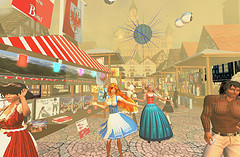RL and SL
This year we seem to see commitments by Linden Lab to help out business and education to come to Second Life more and more. All sorts of announcements have been made — from the launch of Nebraska, the sim-running-behind-a-corporate-firewall solution, to Immersive Workspaces, to LL’s Gold Solution Partner programme, to things like the SL Developers conference — that seem to embrace more and more businesses and educational institutions, and fix them in the landscape of SL. I would say that there has been more success on the academic/educational/research/institutional side, but LL has by far not given up on businesses, and neither have the SL Developers.
A few (including yours truly!) have been wondering if LL would give up on the community altogether — a strong hint was that Robin Harper, who held the community/marketing role at LL, had left early this year. The many “restrictions” that people felt to be “imposed” by the Puritan academics and corporate types also seemed to hint that the Disneyfication of Second Life would continue until all Puritans are happy — and open the wide gate to let SL be flooded by academics and corporations.
This hasn’t happened. Sure, we have the Adult Continent now, but from the lack of very loud complains recently, I would say that my vision of a Red Light District was a bit more accurate than the idea of a “ghetto”. Of course, this means that Adult content — and we’re talking about Triple-X rating here! — was pushed out of the more “moderate” mainland into a special area, but, as said before, this doesn’t mean it was a move to stifle adult content at all. Instead, it fostered a special community to grow: one that has emerged from a common taste — adult content is appealing and fun for a large number of residents, and they should be allowed to have their own space where they are safe (in the sense that no teens are ever likely going to drop there by mistake) and free (in the sense that Puritans are not allowed to complain there 🙂 ).
But on the other hand Linden Lab seems to be pushing a double message: on one hand, that they’re definitely increasing their partnerships with more and more solution providers, encouraging businesses to come to SL, and reaching out to prospective clients; but they’re certainly not forgetting the community, unlike what so many have feared they would do.
There is, however, a double mentality at LL. On the side of the business/academic group, their relationship starts to become more “normal” towards it. Instead of shunning it, or plainly ignoring it, they are behaving like a company that wants to do business. They have their own business-related website. They have a partner programme. They have special mailing lists for business and academics. They do regular business hours which are really “meetings with partners”, like every company does. They have several Lindens with the tag “marketing something” on their job titles (as every company should have!). They use social networking tools profusely — from Twitter to LinkedIn. They have blogs for business and academics. They did, at least once, organise a conference with the Second Life Developers. They promote their partners’ projects, case studies, and even services and products (even if the degree of transparency in promotion is not quite clear). All this is what you would expect from a company that really wants to reach out towards business and a closer relationship with the academic and research institutions.
But on the other hand… they continue to display the “cool guys” attitude towards the community side of their company. They engage volunteers to handle the “first hour experience” in Second Life — the Mentor group continues to be handled just like it was since 2006 (and the Help Islands have little changed since then); while at the same time they grumble because over 90% of all registered users never log in back again — thus, they launch a new crowdsourcing project to write a Second Life Destination Guide to help new users to find interesting things in SL. They have 400+ developers signed-up on their partner list, but the content in SL handled by LL on the mainland is not outsourced, but crowdsourced, from volunteers that just contribute their free work to make SL look nicer. Several of those developers are machinima producers and video/multimedia experts, but they prefer to ask volunteers to donate nice-looking videos for their home page. Legions of professional programmers offer their services through their Developer list, but Snowglobe is an open-source software application developed by individuals volunteering their code to be selected by LL to patch the viewer.
Now, I’m not saying that this is all bad. It’s just that it starts to look weird, from an outsider’s perspective.



